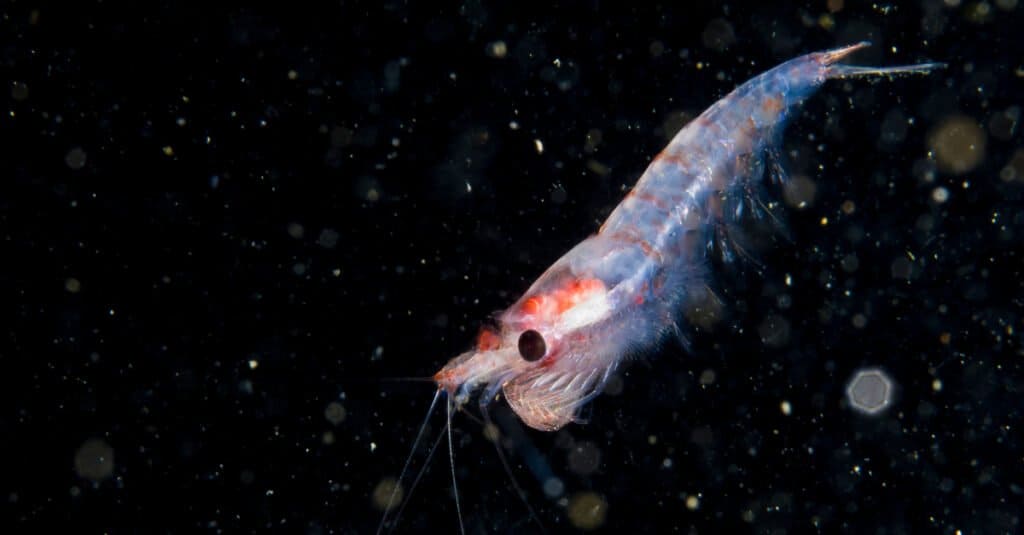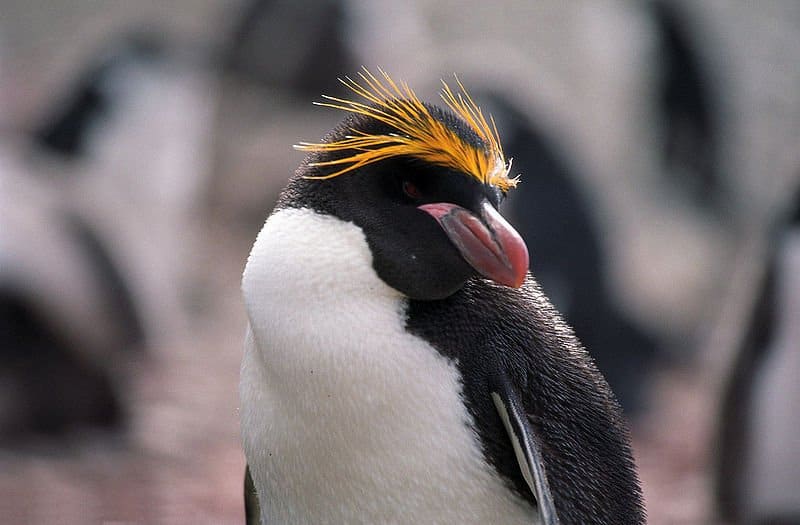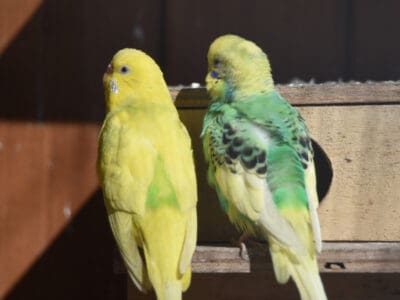10 Incredible Macaroni Penguin Facts
The macaroni penguin, Eudyptes chrysolophus, is part of the genus known as crested penguins. Eudyptes comes from the Greek words eu and dyptes meaning “good” and “diver,” while the words chryse and lophus translate to “golden” and “crest.” English explorers chose to call them macaroni penguins after the term for an 18-century man who wore ornate feathers in his hat. They thought that the penguin’s bright yellow crest resembled the feathers worn by “Macaronis,” hence its name. Today, we’ll discuss 10 different incredible macaroni penguin facts and take a deep dive into what makes these penguins so cool.
10. Macaroni Penguins Eat A Lot

RLS Photo/Shutterstock.com
Krill make up the bulk of food eaten by macaroni penguins, especially during the breeding season. During this time, Atlantic krill may constitute nearly 90% of their diet, and all told, they will eat several million tonnes of krill per year. Some of the other foods that macaroni penguins frequently consume include small fish, squid, and crustaceans. In fact, macaroni penguins eat so much that they consume more marine life each year than any other seabird species,
Like some other penguins, they will also occasionally eat small stones. Different theories abound as to why they engage in this behavior. Some believe that the stones help the penguins when diving by acting as a form of ballast. Still, others think that the stones help the penguins to grind up tough food, such as the shells of crustaceans.
9. Macaroni Penguins Are Amazing Swimmers
Penguins are known to be prolific swimmers, and macaroni penguins are no different. They often travel long distances to find food, with certain groups sometimes found almost 190 miles from their colonies. When foraging, macaroni penguins usually swim at depths between 50 and 230 feet below the surface. However, evidence suggests that they can reach depths of up to 330 feet.
While they normally swim at around 10 miles per hour, they can swim up to 15 miles per hour for short bursts. Additionally, they can hold their breath from 2 to 3 minutes, a trait that allows them to nab dozens of krill or other marine life in a single dive.
8. Macaroni Penguins Have Red Eyes

There are several different animals with red eyes. This trait often occurs in certain amphibians, reptiles, or fish, such as the red-eyed tree frog, eastern box turtle, and red-eyed tetra. Amongst birds, red eyes also appear in black-necked grebes and Indian golden orioles. However, the macaroni penguin’s eyes are particularly bright red and large, which makes them especially notable. In addition to their bright yellow crests and black and white feathers, bright red eyes are one of the macaroni penguin’s most distinguishing features.
7. Male Macaroni Penguins Sometimes Fight One Another
Macaroni penguins are social animals that live in large colonies. However, that does not mean that they always get along. Like humans, they get on each other’s nerves, jostle for space, and compete for limited resources. Macaroni penguins that live close to one another are most likely to resort to aggressive behavior. This makes sense, given their close proximity to one another.
Furthermore, males are apt to display aggressive or territorial behavior with other males. They sometimes engage in bill jousting or using their bills to wrestle with one another. Others will use their flippers to slap one another or peck at each other. This is done to assert dominance or drive off competitors from potential mates. Defeated macaroni penguins will sometimes adopt a submissive stance while walking with their beak pointed to the ground to avoid inviting undue attention.
6. Female Macaroni Penguins Lay Two Eggs But Usually Only Keep One

When most people think of penguins as parents, they think of penguins’ steadfast loyalty to their eggs. This image is not unwarranted, as penguins do go to extreme lengths to raise their young. However, the truth is not as rosy and unblemished as it may seem. A case in point is the tragic example of macaroni penguins and their nearly 50% infant mortality rate.
Female macaroni penguins almost always lay two eggs. However, the first egg is typically significantly smaller than the second egg. This first egg is almost always left unattended by the female and sometimes removed from the nest entirely. As a result, the first egg is rarely, if ever, incubated.
5. Macaroni Penguins Communicate With Body Language
As previously mentioned, macaroni penguins are social creatures that live in large groups. Living in such an environment for thousands of years has allowed them to evolve sophisticated communication skills. While they cannot mimic human speech like parrots or learn sign language like gorillas, macaroni penguins are no slouches when it comes to reading body language.
Macaroni penguins are known to bow to one another as a sign of affection or deference. During courtship displays, males use body language to attract females through preening, extending their necks, and moving their heads from side to side. Moreover, submissive penguins will attempt to make themselves smaller by flattening their feathers, moving their flippers to the front, and lowering their heads.
4. Macaroni Penguin Parents Take Turns Caring For Their Young

Although macaroni penguins have a high egg mortality rate, that doesn’t necessarily make them bad parents. Both male and female macaroni penguins throw themselves into parenting the egg that they choose to keep with zeal. They take turns incubating the egg, with each parent spending around 10-12 days on the nest while the other hunts before switching. During this process, each parent may have to fast for 30 to 40 days at a time and may lose up to 40% of their body weight over the course of the incubation period.
Even after the egg hatches as the chick is born, the job of a macaroni penguin parent is not done. Male macaroni penguins care for their newly hatched chicks by themselves for the first several weeks. During this vulnerable period, the young penguins rely on their parents’ warm fur and bodies to protect them from the cold and predators.
3. Macaroni Penguins Are The Most Populous Penguin Species
There are somewhere between 17 and 20 different penguin species, depending on the source you consult. Of these, macaroni penguins are easily the most common. Estimates suggest that there are around 18 million mature macaroni penguins living in the wild. Many colonies contain over 100,000 individual members, making them among the largest and densest of all penguin species.
2. The IUCN Considers Wild Macaroni Penguins Vulnerable
Despite a large number of macaroni penguins alive in the wild, their population is still threatened. They face a number of substantial threats, including marine pollution, destabilized food sources, and commercial fishing. Such sustained threats have caused several populations to decline by nearly 50 percent within the last 50 years. Others have disappeared completely from certain regions. Due to their loss in numbers, the IUCN currently lists macaroni penguins as a Vulnerable species.
1. Some Macaroni Penguins Get Divorced

It’s a commonly held belief that penguins are monogamous. While this is partly true, it’s misleading to say that all penguins mate for life. Like many birds, penguins often stay together with their mates for many years, but not all species believe in fidelity. For instance, emperor penguins tend to stay with their mates around 85 percent of the time. Meanwhile, king penguins are far from faithful, as they only remain with their mates around 30% of the time.
Macaroni penguin couples tend to stay together around 75 percent of the time. However, “divorces” are not uncommon. This is not to say that macaroni penguins believe in the sanctity of marriage or even have a concept of marriage. Still, it goes to show that even penguins have their fair share of relationship problems.
More from A-Z Animals
The macaroni penguin, Eudyptes chrysolophus, is part of the genus known as crested penguins. Eudyptes comes from the Greek words eu and dyptes meaning “good” and “diver,” while the words chryse and lophus translate to “golden” and “crest.” English explorers chose to call them macaroni penguins after the term for an 18-century man who wore ornate feathers in his hat. They thought that the penguin’s bright yellow crest resembled the feathers worn by “Macaronis,” hence its name. Today, we’ll discuss 10 different incredible macaroni penguin facts and take a deep dive into what makes these penguins so cool.
10. Macaroni Penguins Eat A Lot

RLS Photo/Shutterstock.com
Krill make up the bulk of food eaten by macaroni penguins, especially during the breeding season. During this time, Atlantic krill may constitute nearly 90% of their diet, and all told, they will eat several million tonnes of krill per year. Some of the other foods that macaroni penguins frequently consume include small fish, squid, and crustaceans. In fact, macaroni penguins eat so much that they consume more marine life each year than any other seabird species,
Like some other penguins, they will also occasionally eat small stones. Different theories abound as to why they engage in this behavior. Some believe that the stones help the penguins when diving by acting as a form of ballast. Still, others think that the stones help the penguins to grind up tough food, such as the shells of crustaceans.
9. Macaroni Penguins Are Amazing Swimmers
Penguins are known to be prolific swimmers, and macaroni penguins are no different. They often travel long distances to find food, with certain groups sometimes found almost 190 miles from their colonies. When foraging, macaroni penguins usually swim at depths between 50 and 230 feet below the surface. However, evidence suggests that they can reach depths of up to 330 feet.
While they normally swim at around 10 miles per hour, they can swim up to 15 miles per hour for short bursts. Additionally, they can hold their breath from 2 to 3 minutes, a trait that allows them to nab dozens of krill or other marine life in a single dive.
8. Macaroni Penguins Have Red Eyes

There are several different animals with red eyes. This trait often occurs in certain amphibians, reptiles, or fish, such as the red-eyed tree frog, eastern box turtle, and red-eyed tetra. Amongst birds, red eyes also appear in black-necked grebes and Indian golden orioles. However, the macaroni penguin’s eyes are particularly bright red and large, which makes them especially notable. In addition to their bright yellow crests and black and white feathers, bright red eyes are one of the macaroni penguin’s most distinguishing features.
7. Male Macaroni Penguins Sometimes Fight One Another
Macaroni penguins are social animals that live in large colonies. However, that does not mean that they always get along. Like humans, they get on each other’s nerves, jostle for space, and compete for limited resources. Macaroni penguins that live close to one another are most likely to resort to aggressive behavior. This makes sense, given their close proximity to one another.
Furthermore, males are apt to display aggressive or territorial behavior with other males. They sometimes engage in bill jousting or using their bills to wrestle with one another. Others will use their flippers to slap one another or peck at each other. This is done to assert dominance or drive off competitors from potential mates. Defeated macaroni penguins will sometimes adopt a submissive stance while walking with their beak pointed to the ground to avoid inviting undue attention.
6. Female Macaroni Penguins Lay Two Eggs But Usually Only Keep One

When most people think of penguins as parents, they think of penguins’ steadfast loyalty to their eggs. This image is not unwarranted, as penguins do go to extreme lengths to raise their young. However, the truth is not as rosy and unblemished as it may seem. A case in point is the tragic example of macaroni penguins and their nearly 50% infant mortality rate.
Female macaroni penguins almost always lay two eggs. However, the first egg is typically significantly smaller than the second egg. This first egg is almost always left unattended by the female and sometimes removed from the nest entirely. As a result, the first egg is rarely, if ever, incubated.
5. Macaroni Penguins Communicate With Body Language
As previously mentioned, macaroni penguins are social creatures that live in large groups. Living in such an environment for thousands of years has allowed them to evolve sophisticated communication skills. While they cannot mimic human speech like parrots or learn sign language like gorillas, macaroni penguins are no slouches when it comes to reading body language.
Macaroni penguins are known to bow to one another as a sign of affection or deference. During courtship displays, males use body language to attract females through preening, extending their necks, and moving their heads from side to side. Moreover, submissive penguins will attempt to make themselves smaller by flattening their feathers, moving their flippers to the front, and lowering their heads.
4. Macaroni Penguin Parents Take Turns Caring For Their Young

Although macaroni penguins have a high egg mortality rate, that doesn’t necessarily make them bad parents. Both male and female macaroni penguins throw themselves into parenting the egg that they choose to keep with zeal. They take turns incubating the egg, with each parent spending around 10-12 days on the nest while the other hunts before switching. During this process, each parent may have to fast for 30 to 40 days at a time and may lose up to 40% of their body weight over the course of the incubation period.
Even after the egg hatches as the chick is born, the job of a macaroni penguin parent is not done. Male macaroni penguins care for their newly hatched chicks by themselves for the first several weeks. During this vulnerable period, the young penguins rely on their parents’ warm fur and bodies to protect them from the cold and predators.
3. Macaroni Penguins Are The Most Populous Penguin Species
There are somewhere between 17 and 20 different penguin species, depending on the source you consult. Of these, macaroni penguins are easily the most common. Estimates suggest that there are around 18 million mature macaroni penguins living in the wild. Many colonies contain over 100,000 individual members, making them among the largest and densest of all penguin species.
2. The IUCN Considers Wild Macaroni Penguins Vulnerable
Despite a large number of macaroni penguins alive in the wild, their population is still threatened. They face a number of substantial threats, including marine pollution, destabilized food sources, and commercial fishing. Such sustained threats have caused several populations to decline by nearly 50 percent within the last 50 years. Others have disappeared completely from certain regions. Due to their loss in numbers, the IUCN currently lists macaroni penguins as a Vulnerable species.
1. Some Macaroni Penguins Get Divorced

It’s a commonly held belief that penguins are monogamous. While this is partly true, it’s misleading to say that all penguins mate for life. Like many birds, penguins often stay together with their mates for many years, but not all species believe in fidelity. For instance, emperor penguins tend to stay with their mates around 85 percent of the time. Meanwhile, king penguins are far from faithful, as they only remain with their mates around 30% of the time.
Macaroni penguin couples tend to stay together around 75 percent of the time. However, “divorces” are not uncommon. This is not to say that macaroni penguins believe in the sanctity of marriage or even have a concept of marriage. Still, it goes to show that even penguins have their fair share of relationship problems.







